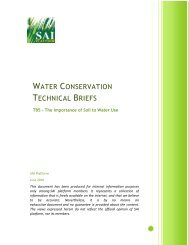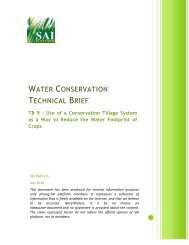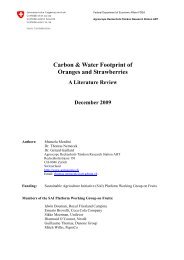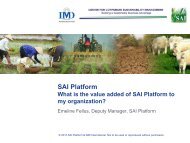Agriculture, food and water - FAO.org
Agriculture, food and water - FAO.org
Agriculture, food and water - FAO.org
You also want an ePaper? Increase the reach of your titles
YUMPU automatically turns print PDFs into web optimized ePapers that Google loves.
38 CHAPTER 5 Trends in irrigation-<strong>water</strong> management<br />
Increasing private investment in irrigation<br />
Investment in large irrigation projects increased in the 1970s <strong>and</strong> then fell by more than 50 percent<br />
in the 1980s. It further declined in the 1990s. Most of the <strong>water</strong>-related infrastructure projects over<br />
the past forty to fifty years were financed by the governmental sector with significant intervention<br />
by the international development banks. Development costs for new irrigation l<strong>and</strong>s have increased<br />
markedly in recent years; for example, costs have been increasing by more than 50 percent in the<br />
Philippines, 40 percent in Thail<strong>and</strong> <strong>and</strong> have nearly tripled in Sri Lanka. With declining crop<br />
prices, it is difficult to justify new irrigation development. Financial capability is lacking for new<br />
infrastructure as well as for modernizing present structure <strong>and</strong> ensuring system sustainability.<br />
Recently there has been an increase in the private-sector financing of large <strong>water</strong>-sector<br />
infrastructure, <strong>and</strong> small-scale irrigation systems. According to the World Bank, 15 percent of<br />
the infrastructure is currently being financed through private funds, <strong>and</strong> this is part of a growing<br />
trend. Ground<strong>water</strong> development has proved a particularly attractive target for private investment<br />
because of the private level of control it offers.<br />
Reforming irrigation: modernization <strong>and</strong> empowerment<br />
During the green revolution of the 1960s <strong>and</strong> 1970s, making irrigation <strong>water</strong> available to farmers<br />
had a high priority. Governments had surface irrigation systems established <strong>and</strong> managed through<br />
public sector agencies. Some large-scale systems were poorly designed, with insufficient provision<br />
for drainage <strong>and</strong> consequent soil degradation. System management often failed to respond to the<br />
needs of users, in particular of smallholders <strong>and</strong> sectors carrying low social <strong>and</strong> political weight.<br />
Water-use fees were not collected or not applied to proper system operation <strong>and</strong> maintenance.<br />
Large rehabilitation needs emerged <strong>and</strong> as governments <strong>and</strong> international lending institutions<br />
found it difficult to raise funds for this purpose, it became clear that the economic <strong>and</strong> social<br />
context of large-scale irrigation needed to be reformed.<br />
Reforming efforts focused on transferring responsibility for operating <strong>and</strong> maintaining irrigation<br />
systems to the farmers, <strong>org</strong>anized in <strong>water</strong>-user associations. This highlighted the need for building<br />
<strong>and</strong> developing managerial capacity among stakeholders, while confining irrigation-system<br />
administration to the role of <strong>water</strong>-service provider. Empowerment alone may not be sufficient<br />
unless deficiencies in design <strong>and</strong> operation <strong>and</strong>/or upgrade of infrastructures are addressed.<br />
Irrigation modernization is a process of change from supply-oriented to service-oriented<br />
irrigation. It involves institutional, <strong>org</strong>anizational <strong>and</strong> technological changes <strong>and</strong> transforms a<br />
traditional irrigation scheme from protective to productive irrigation. The modernization <strong>and</strong><br />
transfer of some management responsibilities of government-held irrigation systems to <strong>water</strong>-user<br />
associations <strong>and</strong> service-providing companies have been carried out in several countries such as<br />
Mexico, China <strong>and</strong> Turkey <strong>and</strong> has proved beneficial in certain cases. However, governments














